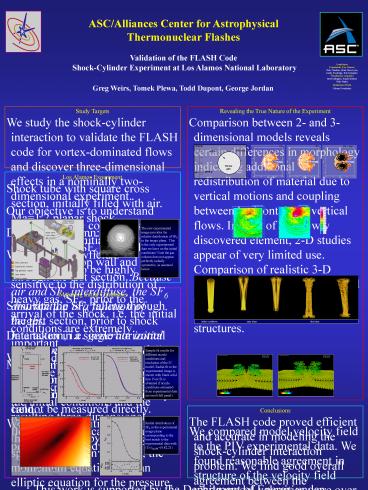ASCI Site Review PowerPoint PPT Presentation
1 / 1
Title: ASCI Site Review
1
ASC/Alliances Center for Astrophysical
Thermonuclear Flashes
Validation of the FLASH Code Shock-Cylinder
Experiment at Los Alamos National Laboratory
Contributors Experiments (Los Alamos) Chris
Tomkins, Mark Marr-Lyon, Kathy Prestridge, Bob
Benjamin Visualization (Argonne) Brad Gallagher,
Randy Hudson Mike Papka Simulations
(Flash) Vikram Dwarkadas
Greg Weirs, Tomek Plewa, Todd Dupont, George
Jordan
- Revealing the True Nature of the Experiment
- Comparison between 2- and 3-dimensional models
reveals certain differences in morphology
indicating additional redistribution of material
due to vertical motions and coupling between
horizontal and vertical flows. In light of this
newly discovered element, 2-D studies appear of
very limited use. Comparison of realistic 3-D
model to experiment, shows good overall agreement
of morphology of large and medium scale
structures. - We compared model velocity field to the PIV
experimental data. We found reasonable agreement
in structure of the velocity field while model
velocities were over 50 larger than in
experiment. This discrepancy does not necessarily
imply serious problem since our early 3-D
calculation did not benefit from the detailed
analysis of the initial conditions. - Development of genuinely three-dimensional
structures is clearly revealed by volume
rendering of the heavy gas distribution. Note the
initially perfectly radially symmetric
distribution of heavy gas is deformed due to
deposition of vorticity along the columns
surface. Sheets of heavy gas isolated by air
progressively wrap around vortex cores, with
small scale structure eventually developing at
the air-SF6 interfaces. Tilting of the column
closely resembles the experimental result of
Jacobs (1993).
- Study Targets
- We study the shock-cylinder interaction to
validate the FLASH code for vortex-dominated
flows and discover three-dimensional effects in a
nominally two-dimensional experiment. - Our objective is to understand behavior of the
complete system, including the initial
conditions. - We find the flowfields development to be highly
sensitive to the distribution of heavy gas, SF6,
prior to the arrival of the shock, i.e. the
initial conditions are extremely important. - We provide motivation and guidance for further
development of the experiment, diagnostics of the
initial conditions and the resulting
three-dimensional flowfield as indicated by our
predictive hydrodynamic model.
2D
3D
3D exp.
- Los Alamos Experiment
- Shock tube with square cross section, initially
filled with air. Ma1.2 planar shock. - Dense gas column sulfur hexafluoride (SF6)
enters from a nozzle in the top wall and falls
through the test section. Because air and SF6
interdiffuse, the SF6 distribution is a function
of height. - Data taken in a single horizontal plane, 2 cm
below the top wall. CCD cameras used for imaging
initial conditions and evolution PIV data for
analysis of velocity field.
experiment
simulation
The raw experimental image provides the relative
distribution of SF6 in the image plane. This is
the only experimental data we have on the initial
conditions! Note the gas column does not appear
perfectly radially symmetric, as assumed below.
- Matching Initial Conditions
- Simulate the SF6 falling through the test
section, prior to shock interaction, i.e.
generate initial conditions for FLASH simulations - Main goal is to determine maximum initial mole
fraction, XSF6, in image plane which cannot be
measured directly. - We model the initial evolution of the gas column
by solving a species advection equation, the
momentum equation, and an elliptic equation for
the pressure, with constant gravity, viscosity,
and species diffusion, in axisymmetric geometry. - Choose inlet velocity and the initial SF6 mass
fraction, then run until steady state is
achieved. - Construct goodness-of-fit map of the initial
conditions extracting SF6 radial profile in image
plane and compare to experimental data.
initial conditions
early times
final time
Sample fit results for different nozzle
conditions and resolution of the IC model. Radial
fit to the experimental image is shown with black
solid line. Poor fit is obtained if nozzle
conditions estimated from experimental data are
used (left panel).
- Conclusions
- The FLASH code proved efficient and accurate in
modeling the shock-cylinder interaction problem.
We find good overall agreement between the
experiment and numerical model in both morphology
and dynamics (Weirs, Dupont, Plewa 2006, Phys.
Fluids, in preparation). - The shock-cylinder interaction problem is
genuinely 3-dimensional. The magnitude of
vertical motions is similar to that of horizontal
motions in the cylinders frame of reference. - Modeling of the initial conditions clearly
indicates strong vertical stratification. We
identified a one-parameter family of initial
conditions which is consistent with the
experimental data. - Mixing occurs due to shock-induced horizontal
shear as well as due to stratification-induced
vertical shear. We use tracer particles to study
the interaction between the two processes. - Development of additional diagnostics (initial
conditions, vertical plane) is highly desirable
and will enable critical evaluation of our
predictive results.
Radial distribution of SF6 in the experimental
image plane corresponding to the best match to
the experimental data with (Y,v)in,SF6(0.82,21).
This work is supported by the Department of
Energy under Contract No. B523820 to the Center
for Astrophysical Thermonuclear Flashes at the
University of Chicago.

